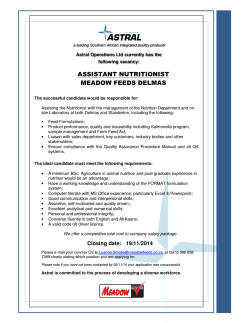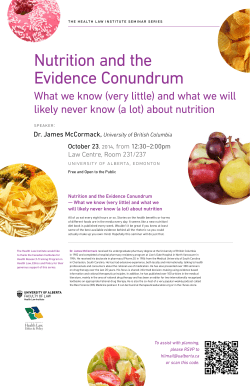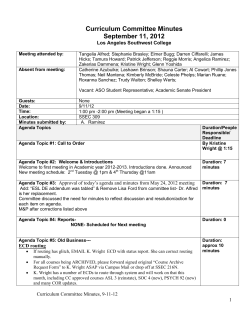
Salojee. Child care 1st 1000 days
The status of child care in the first 1000 days in South Africa HAROON SALOOJEE Agenda What is child care? Can we measure child care? What do the indicators tell us? Can we trust the indicator data? How should we respond to the current situation? What is child care (in the first 1000 days) ? Being born alive Being born healthy Having a mother/father/caregiver Receiving shelter, food, warmth, … Having birth registered Surviving the neonatal period and infancy Being protected from disease and ill health Being protected from abuse, neglect and exploitation Receiving love and play Opportunities for early learning (stimulation) Can we measure child care (and what do the indicators tell us) ? Being born alive Being born healthy Having a mother/father care for you Receiving shelter, food, warmth, … Having birth registered Surviving the neonatal period and infancy Being protected from disease and ill health Receiving love and play Being stimulated Only a third of children live with both parents in South Africa How effective is coverage of existing child care services and activities ? Safe birth Breast-feeding Growth promotion Immunisation Developmental screening Vitamin A supplementation Deworming Child support grants Child social support grants (millions) Can we trust the indicator data? Mortality Low birth weight and prematurity Immunisation Breastfeeding Child support grant Are there things we do not know (nationally)? Nutrition Hygiene (hand washing with soap) Zinc delivery Developmental problems Who cares for young children? What opportunities for early learning (stimulation) provided? …. much more What’s the problem? Inadequate and inequitable coverage of key services Under-provided services - food and nutrition, child care and early learning, parenting support Exclusion of vulnerable children – youngest, poorest and in under-serviced areas Poor quality linked to funding, poor qualifications and limited quality improvement What barriers to effective child care service provision need to be overcome? A poor or absent legislative framework, Insufficient or no public funding, Poor governance, including institutional arrangements Inefficiencies Leadership Co-ordination What are the opportunities for effective child care and how can they be realised? Best good news for 2015? An essential package for the first 2 years of life Health Care Child: Health care, HIV testing & treatment, de-worming , disability (DOH) Mother: substance abuse, mental health, exposure to violence (DOH) Nutrition Growth monitoring, breastfeeding, Vit A, complementary & responsive feeding, nutrition counselling, supplementation when necessary (DOH) Birth Registration & Social, Child Protection CSG (SASSA), screen abuse & neglect (DOH, DSD) Parent Support Parent support and skill building (DOH) Opportunities for learning Home visits, community & facility groups (DOH), child minding (DSD) • Birth registration • Child Support Grants (DSD/SASSA) • Large part of Health & Nutrition (DOH) Already in place • Nutrition support • Screening, support & referral • Maternal mental health, substance use, exposure to violence • Child abuse, children with disabilities • Centre- and programme-based early learning Must beregulated & supportedorchild expanded minding State supported • Parent support • Home, child minder and community opportunities for learning for young children (<2y) • Community- and media-based promotion of child development, growth, health, safety and learning New services needed How does one rapidly expand the Essential Package? International and local experience of achieving high coverage India: International Child Development Services (ICDS) USA: Early Head Start Britain: Sure Start Latin America: Chile, Colombia South Africa: Grade R Responsibilities of an ECD “agency” Plan, coordinate & monitor national programme of ECD Support key government departments Develop & support implementation of specific programmes Nutrition support. Parenting Early support learning Establish high level targets and norms and standards Strengthen alignment of budget bids with the national ECD Policy Priorities for ECD “agency” Home- and community-based support for children <2 years Expanded opportunities for learning for children 2-5 years Clear strategies to prevent stunting Support for children with developmental difficulties and disabilities Communication and public information about ECD Infrastructure • Service delivery • Management Human Resources • Mother and Child health workers • ECD practitioners • Child minder supervisors • ECD Management Training Monitoring, evaluation and quality control ECD Agency DOH: Pregnancy, Birth–2 years Pregnancy 2 home visits (vulnerable mothers - <19, HIV+, substance abuse, mental ill-health, exposure to violence) Clinic- and community-based mother support groups Birth to 2 Years Home visits for 9 months to vulnerable mothers Home visits to 9 months for vulnerable infants Clinic- and community-based mother support groups, motherbaby early learning groups (e.g. WHO/UNICEF Care for Child Development) By whom? New Mother & Baby Community Health Workers DSD/DBE: Birth-2 and 2-5 Years Birth to 2 Years Support to Child Minders 2 – 5 Years Centre- and community-based early learning groups and parent supports Backed-up By whom? ECD by toy and book libraries practitioners Possibility of pre-Grade R year at 3.5 years Conclusion Child care is very much on the national agenda The data we have is modestly robust, and limited, but indicates that our performance varies (from great to poor) Many of the key elements of an Essential Package are already in place, but require quality improvements The challenge now is to debate the currently proposed strategies and identify other (cost) effective strategies, and most importantly… get on with implementation
© Copyright 2025
















